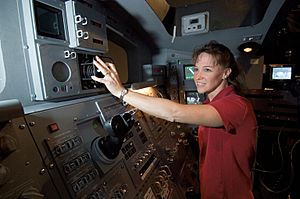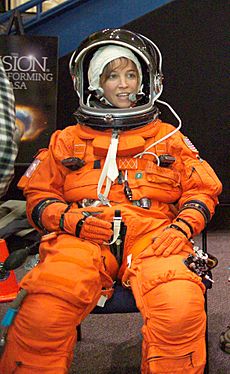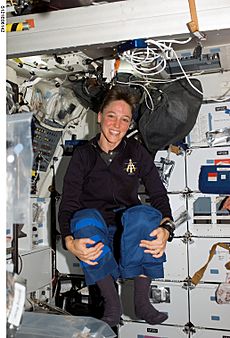Lisa Nowak facts for kids
Quick facts for kids
Lisa Nowak
|
|
|---|---|
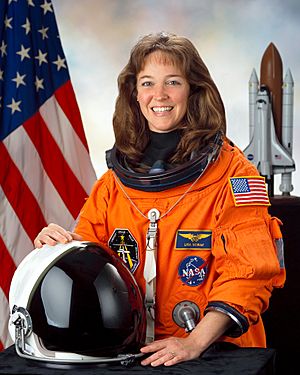
Nowak in 2005
|
|
| Born |
Lisa Marie Caputo
May 10, 1963 Washington, D.C., U.S.
|
| Awards |
|
| Space career | |
| NASA astronaut | |
| Rank | Commander, USN |
|
Time in space
|
12d 18h 36m |
| Selection | NASA Group 16 (1996) |
| Missions | STS-121 |
|
Mission insignia
|
|
Lisa Marie Nowak (born May 10, 1963) is an American aeronautical engineer, a former NASA astronaut, and a retired officer from the United States Navy. Nowak served as a naval flight officer and test pilot in the Navy. She was chosen by NASA in 1996 to become an astronaut. She flew into space on the STS-121 mission in July 2006. During this mission, she was in charge of operating the robotic arms of the Space Shuttle and the International Space Station. After her space flight, Nowak faced personal challenges that led to her leaving NASA and the Navy.
Contents
Early Life and Education
Lisa Marie Caputo was born in Washington, D.C., on May 10, 1963. Her parents were Alfredo F. Caputo, a computer consultant, and Jane L. Caputo, a biological specialist. Lisa and her two younger sisters grew up in Rockville, Maryland. In 1969, she watched the Apollo 11 Moon mission. This event sparked her interest in the space program. As she grew up, she followed the Space Shuttle program. She was especially interested when women astronauts were first introduced in 1978. She often visited the National Air and Space Museum.
Caputo attended Luxmanor Elementary School, Tilden Middle School, and Charles W. Woodward High School in North Bethesda, Maryland. In her junior year of high school, she told her mother she wanted to become an astronaut. She was a Girl Scout. She was also a member of the Société Honoraire de Français, which required high grades in French and other subjects. She was on the math team and her class student council. She also played field hockey and competed in track and field athletics. In 1981, she was named Student Athlete of the Year. This award goes to students who excel in both sports and academics. She graduated as co-valedictorian, meaning she had one of the highest academic achievements in her class.
In her final year of high school, Caputo was accepted by Brown University and the United States Naval Academy in Annapolis, Maryland. Her parents thought Brown was the best choice. However, Caputo felt she had a better chance of becoming an astronaut by going to the Naval Academy. Women were first allowed into Annapolis in 1976. By the time Caputo started in 1981, women made up only 6 percent of the students. She competed on the track team as a student. She graduated on May 22, 1985. She earned a Bachelor of Science degree in aeronautical engineering. She then became an ensign in the United States Navy.
For her first job, Caputo chose to work for six months at the Johnson Space Center. She worked as an aerospace engineer at its branch near Houston, Texas. During this time, six Space Shuttle launches happened. She later said she was impressed by how excited everyone was about their work. They believed their part was very important.

In December 1985, Caputo was sent to Naval Air Station Pensacola in Florida for flight training. At that time, women were not allowed in combat roles. This meant half of the Navy jobs were not open to women. Getting into flight training was a big achievement. Caputo finished her first flight training at Naval Air Station Pensacola. She flew the T-2 Buckeye, T-39 Sabreliner, and TA-4J Skyhawk. She became a naval flight officer (NFO) in June 1987.
Caputo continued her NFO training at the Electronic Warfare School. She then went to Naval Air Station Lemoore. There, she learned to operate electronic systems on the LTV EA-7L Corsair II. On April 6, 1988, she married Richard T. Nowak, a classmate from Annapolis. She then changed her last name to "Nowak". Her next job was with Electronic Warfare Aggressor Squadron 34 (VAQ-34). She flew both the Corsair II and the Douglas ERA-3B Skywarrior. She supported the U.S. Pacific Fleet in reconnaissance mission exercises. She became a mission commander and electronic warfare lead.
In 1990, Nowak attended the Naval Postgraduate School in Monterey, California. She earned a Master of Science degree in aeronautical engineering and a degree in aeronautical and astronautical engineering in September 1992. She wrote her thesis on how airfoils behave in certain conditions. She gave birth to a son in February 1992. After graduate school, she became an Aerospace Engineering Duty Officer. She was chosen to attend the United States Naval Test Pilot School in Naval Air Station Patuxent River, Maryland. She had applied six times before being accepted. She graduated in June 1994.
After graduation, she worked on aircraft systems projects. She helped develop the F/A-18 Hornet and EA-6B Prowler. Her next role was with the Naval Air Systems Command. There, she helped acquire new systems for naval aircraft. During her Navy career, Nowak flew over 1,500 hours in more than 30 different aircraft. She received several awards, including the Defense Meritorious Service Medal, the Navy Commendation Medal, and the Navy Achievement Medal.
NASA Career
Astronaut Training
On June 15, 1995, NASA announced it was choosing a new group of astronauts. As a Navy officer, Nowak had to apply through a special review board. The board approved her application and sent it to NASA. NASA received over 2,400 applications. In early 1996, Nowak was told she was one of 150 finalists. She was asked to come to Johnson Space Center for a week of interviews and medical checks.
On May 1, 1996, NASA announced the names of 10 pilot and 25 mission specialist candidates. Nowak was one of the mission specialists. This group of 35 astronauts was the largest chosen since 1978. They started their training at Johnson Space Center on August 12, 1996. Nine international astronauts also joined them. Because there were so many, they called themselves "The Sardines."
Nowak and her family moved to Texas. Her husband, also a naval flight officer, left active duty in 1998. He continued to fly in the United States Naval Reserve. He found a job as a space communications contractor. He worked at the Johnson Space Center as a flight controller at the mission control center.
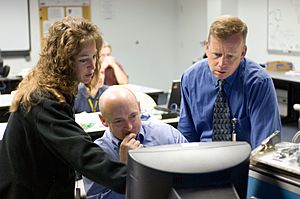
Astronaut training included survival skills. They also took a three-day trip to the Grand Canyon to study geology. They learned about the Space Shuttle's many systems. As a mission specialist, she had to fly at least four hours a month in NASA's Northrop T-38 Talon aircraft. Training also took place in the Weightless Environment Training Facility. This is a large pool where astronauts practice in a weightless environment. They also trained in the Boeing KC-135 Stratotanker, known as the Vomit Comet. This plane flies in a way that makes you feel weightless. She finished her astronaut training in August 1998.
In early 2001, Nowak became pregnant with twins. At the Astronaut Office, Nowak focused on operating the Space Shuttle's robotic arm. She also worked with the CAPCOM Branch. These astronauts communicate with the spacecraft from mission control. She did this during the STS-100 mission in April 2001. During that mission, a robot arm was installed on the International Space Station (ISS). In October 2001, she gave birth to twin daughters.
On December 12, 2002, NASA announced the crew for STS-118. This mission was planned for November 2003. The Space Shuttle Columbia disaster happened on February 1, 2003. Seven astronauts died on the STS-107 mission. This included three from Nowak's 1996 astronaut class. Nowak helped the family of her close friend Laurel Clark after the disaster.
The disaster caused many changes to mission schedules and equipment. A second Return to Flight mission, STS-121, was added to test new safety features. This mission would also resupply the ISS with equipment.
In January 2004, Nowak took part in an eleven-day cold weather survival training course in Canada. She was with other astronauts and cosmonauts. They learned survival skills from the Canadian Armed Forces. Then, they were dropped in the wilderness in northern Quebec. They had to find their way back on foot. They covered 20 kilometers in eleven days.
Space Flight
NASA announced in December 2003 that Steven Lindsey would command STS-121. On November 18, 2004, NASA announced that Nowak and her classmate Stephanie Wilson would join the STS-121 crew. They were given the job of controlling the robotic arms of the Space Shuttle and the ISS. The STS-121 mission was delayed several times to ensure all safety changes were ready.
A party was held for Nowak before the launch at the Kennedy Space Center Visitor Complex. Her parents, husband, children, and friends joined her. She packed personal items for the flight. These included a small owl figurine from her elementary school, a koozie from her middle school, a banner from her high school, an Annapolis Class of 1985 flag, and her grandmother's engagement ring.
On July 1, 2006, the STS-121 crew ate the traditional prelaunch cake. They then boarded Discovery at Kennedy Space Center Launch Complex 39B. Nowak was the last crew member to enter the spacecraft. She took her seat as the flight engineer. The launch was delayed twice due to bad weather. STS-121 successfully launched on July 4 at 2:38 PM. It was the first time a Space Shuttle launched on Independence Day.
After reaching orbit, Nowak felt nauseated, a common symptom of space adaptation syndrome. The first day in space was spent checking the orbiter for damage. Nowak used the robotic arm to inspect the spacecraft. After six and a half hours, they found only a white spot on the nose cap. Engineers thought it might be from an impact, but it turned out to be bird droppings.
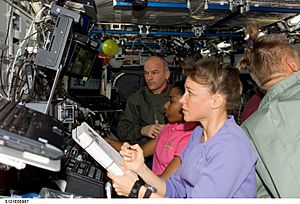
After Discovery docked with the ISS, Wilson and Nowak used the Canadarm to unload the Italian-built Leonardo Multi-Purpose Logistics Module (MPLM). This module contained 7,400 pounds of equipment and supplies. These included a freezer for scientific experiments and an Oxygen Generating System. This system would allow the ISS to support more crew members. Nowak completed her assigned tasks.
While Discovery was docked with the ISS, the STS-121 crew performed three spacewalks. Women astronauts were not chosen for spacewalks at that time. This was because smaller space suit sizes were not available. Women astronauts were assigned other tasks, like operating the robotic arms. From the Destiny laboratory on the ISS, Nowak operated the robotic arm. This arm was more challenging to use than the one on the Space Shuttle.
About 4,300 pounds of trash and broken equipment were packed into Leonardo. Nowak and Wilson used the robotic arm to put the module back into Discovery's cargo bay. The arm was then used to check the Space Shuttle one last time for any damage. Discovery undocked from the ISS and began its two-day return to Earth. In total, she spent 12 days, 18 hours, and 36 minutes in space. During this time, she traveled 5 million miles. Discovery landed at the Shuttle Landing Facility at the Kennedy Space Center at 9:14 AM on July 17.
Homecoming
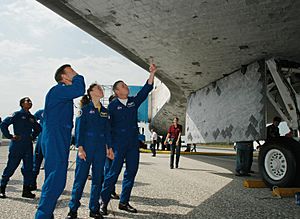
After the mission, the six crew members of STS-121 took part in many public events and interviews. They attended X Games XII in Los Angeles and a Houston Astros baseball game. On September 9, Nowak attended a party at the Naval Academy. She gave her classmates the Class of 1985 flag she had carried on the Space Shuttle. She also signed photographs. At halftime, she gave Annapolis a Navy jersey she had carried on Discovery. She gave an interview to Ladies' Home Journal and presented awards at NASA's Stennis Space Center. She visited Luxmanor Elementary School and Tilden Middle School to speak to children. She also attended celebrations at Annapolis for the 30th anniversary of women being admitted. In December, the STS-121 crew visited the UK. They went to the University of Edinburgh and the National Space Centre. They also spoke at the University of Leeds.
Later Life
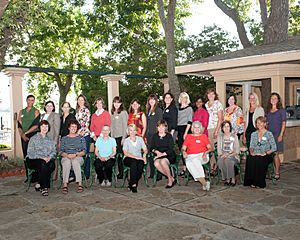
After her space flight, Lisa Nowak faced personal challenges. Her marriage ended in 2008. She was given full custody of her three children. In 2007, she was involved in a highly publicized incident in Florida. This led to her being removed from the astronaut program. She was later dismissed from the Navy.
After leaving NASA and the Navy, Nowak found it difficult to find new employment. This was due to the public attention surrounding her case. In 2017, People magazine reported that Nowak was living quietly in Texas. She was working in the private sector. Her attorney stated that she was "doing well."
See also
 In Spanish: Lisa Nowak para niños
In Spanish: Lisa Nowak para niños



